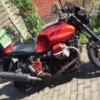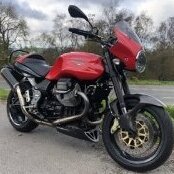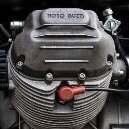-
Posts
349 -
Joined
-
Last visited
-
Days Won
7
Tinus89 last won the day on January 25
Tinus89 had the most liked content!
About Tinus89
- Birthday 07/27/1989
Profile Information
-
Location
Groningen, Netherlands
-
My bike(s)
V11 Sport Mandello Rosso, Aprilia Tuareg 660, V65 Florida (build in progress)
Tinus89's Achievements

Guzzisti (2/5)
230
Reputation
-

ANSWERED Voltage regulator broken? Confirmed.
Tinus89 replied to Tinus89's topic in Technical Topics
Discussed the specifics of their R/R with them, also when wired directly to the battery. Their R/R only switches the +12v connection on when it see an AC voltage, thereby preventing mA draw with the bike off. I also asked them if they could lengten the + and - wires (originally 57cm) to 120cm with the connectors separate. "Absolutely no problem, just let us known in the comments when you order". So I ordered and received a sent confirmation only about 3 hours later. I received the regulator, with 120cm of wire on it, nicely sleeved all the way. Drilled new holes in the mounting bracket (and gave it a lick of paint) & tested the bike: shockingly stable charge voltages. Problem solved. -

ANSWERED Voltage regulator broken? Confirmed.
Tinus89 replied to Tinus89's topic in Technical Topics
That is absolutely the case! I have this properly arranged & also measured from a random spot on the case to the battery negative terminal at 0.0 Ohm. But I was hoping Lucky Phil could shed some light onto how this parasitic draw would run. -

ANSWERED Voltage regulator broken? Confirmed.
Tinus89 replied to Tinus89's topic in Technical Topics
Phil, how exactly would this happen? Because looking at this wiring schematic, all connections are direct and not switched: -

ANSWERED Voltage regulator broken? Confirmed.
Tinus89 replied to Tinus89's topic in Technical Topics
Locally, we also have this company supplying electronics for motorbikes. I have their ignition system on my V65 Florida, and when I ran into a problem with no spark, they helped me out via phone on a friday afternoon at 1740hrs until after 1800hrs without any complaining (with the friday afternoon drinks in the background). They have this: https://www.carmo.nl/index.php?main_page=product_info&cPath=4318_1086&products_id=616&language=en&zenid=99a86542fb47940f10005a7f36e22d6b Albeit significantly higher priced compared to Docc's link. -

ANSWERED Voltage regulator broken? Confirmed.
Tinus89 replied to Tinus89's topic in Technical Topics
Yes, the 30A fuse is good (has been replaced with a Midi Fuse holder a while back due to a hot 30A fuse). Thanks for getting onto your soapbox haha! Personally, for things like these, I would absolutely stay away from buying something which is not the real thing. Rather spend a Euro or two more. That being said, with my location being Europe (Netherlands), buying the regulator in a US shop is not most efficient... Checked, cleaned & treated (Caig DeOxit) all connections from the regulator with the exception being the connections behind the instrument dash. My idle is also a bit low, but it is moreso the high charge with load (15+V) which concerns me most. I know Phil, which is what I have done, with the exception of the terminals at the back of the instrument dash light. But given the light works, is that still worth doing so for the operation of the regulator? It has a specific ground to battery & a second (3rd?) specific ground to the engine case. Measuring resistance from regulator case to battery negative gives 0.0 Ohm. -

ANSWERED Voltage regulator broken? Confirmed.
Tinus89 replied to Tinus89's topic in Technical Topics
At idle, when the engine is warmed up. Sometimes it burns really solid, sometimes it comes and goes. Always at idle, never above. -
Tinus89 started following Voltage regulator broken? Confirmed.
-
Hi all, Recently I noticed the charge light on the dash illuminating at idle more frequently. The battery is recent, measures 12,85v with everything off and cold starts are no problem. 2001 V11 Rosso Mandello non-limited edition series, 47k km, suspect original regulator. I therefore checked the charging voltages at the battery: - Idle, lights off: 12,9v - Idle, lights on: 12,4v but fluctuating on a downwards trend, eventually going below 12v - 3k rpm lights off: 13,9v - 3k rpm lights on: 14,8v. This seems high, when I switch on/off the lights this moves the charge voltage between 13,8v and 14,8v. I am running an aftermarket LED H4 replacement, so I thought: maybe that throws the regulator off. Replaced it with a normal H4 bulb & redid the measurements. Basically the same behavior, however with a better "idle lights on" voltage of 13,3v, however when I switch on the lights at 3k rpm, the charge volts jump to 15,1v!! Also using the horn (the only other significant switchable consumption on the bike), raises the charge from 13,8v to 14,8v. I confirmed all connectors are good and both charge lead to battery (via 30A fuse) as well as ground from regulator case to battery come in at 0,0 Ohm. I also confirmed the two yellow wires to the generator are in good condition (also the infamous connection on the stator). Question: is there something in the charge light circuit that could cause this behavior (I have not yet dismounted the dash to take measurements there) or is symply my regulator on it's way out?
-
I am no electrics guy, so I may not understand, but what I meant is essentially what GuzziMoto wrote: I think that an added resistor (instead of the bulb) will protect the thermistor and therefore safeguard the intrinsically safe system in the tank, but I think even with the high resistance of thermistor & resistor, the current flowing is still enough to light the LED. As the LED lights with the thermistor cold (and ~ 1800ohm - I have not measured yet), it will most likely also light with the 1800+150ohm resistance... However, would switching the LED through a 100mA relay not work? Something like this (https://www.diverseelectronics.com/upload/documents/SARA.pdf), which can only close at ~100mA (which almost lights the incandescent bulb). I would suppose the coil in the relay would still allow some current to flow for the thermistor to heat up & keep it's function. Also, are we confident this fuel gauge works with a thermistor as well? Because it has a small "float" as can be seen on the picture: Keeping the stock bulb is not an option. I have a set of LEDs nicely built into the handlebar clamp, the incandescent bulb simply does not fit there. Making an electronic solution is less work than going back to the original bulb...
-
The original bulb is 1.2W. But I am failing to understand how this would work. Adding a resister similar to the 1.2W bulb would only "help" the fuel level sensor in not becoming too hot, right? Would it, in "full" position, still not allow sufficient current to flow through the high resistance in the fuel level sensor to light the LED bulb?
-
On my V65 Scrambler, I changed all the bulbs (and the whole dash) for LED's. My tank came with a level sensor which I think (but will have to take those measurements) works the same way. This is the gauge: https://www.stein-dinse.com/en/nml-moto-guzzi-petcock-electrically-left-side-mille-gt-sp/item-2-1084757-23105370-.html So obviously I discovered the light is always on. Reading your story, would installing a properly sized resistor in series with the fuel gauge be an option, with the LED parallel to the resistor?
-

(ex) V65 Florida no start after changing headgaskets
Tinus89 replied to Tinus89's topic in Older models
Lovely (potential) ladies and gentlemen. White smoke. The issue has been found! Long story short, I have been changing components left/right so many times now, I lost the baseline. During this process, I had an intermittend spark, which in turn was intermittend again. I got frustrated, cursed, wanted to push the bike into a canal. Decided to start over. Begin at the base I was left off with (which was with the signal wires of the pickup crossed). Put some fuel in her, had a huge backfire (remember the crossed wires?) But hey, the size of the backfire was new. Switched the wires back and BOOM. Started up "like a dream" But why? And then there was it. I had already abused one lithium battery to failure. In the process of getting the fueling so that she would start quick, I jumpered the battery of my V11 onto her. I only used the engine ground (and not the central ground point cable I also engineered into it) and she ran fine (before the head gaskets). The only thing that changed between the last no-run-with-fuel and yesterday's baseline attempt, was I added a central ground wire. I never looked into that because she ran fine without it earlier. Started the bike, removed the ground cable and she died. Repeated 4 times without failure. So yeah, the luck of the bike running without that main ground, turned into a big search later. The real story? I sold my Caponord 1000 two months ago to a friend. Yesterday I received my Aprilia Tuareg 660 AND found out the above. Moral of the story? I just needed a new bike Thanks everyone for thinking along! -

My engine is pinging when loading it, above 4000 rpm...
Tinus89 replied to p6x's topic in Technical Topics
My V11 pinged in the 4000-5500rpm range during warmer weather and WOT. She is equipped with pod filters (PO did that, I like the sound so I keep them). I solved the problem by (in steps) increasing the fueling using Guzzidiag and Tune ECU ( I thought that was the software, but could have been the Aprilia Caponord as well) in that area slightly. -
Dismantle the starter and look inside. I am 99% sure you will see one or more loose magnets. I had the EXACT same symptoms. Replaced the battery, no change. Until I disassembled the starter itself and found one magnet laying loose. Roadside assistance helped me hook up a van battery (like a huge car battery), and the dead short in my starter pulled the van battery down to 7v!! After a few taps on the starter (which most likely relocated the magnet) she started up like nothing ever happened.
-

(ex) V65 Florida no start after changing headgaskets
Tinus89 replied to Tinus89's topic in Older models
Yes, it is. I have been fiddling with the ignition for a while now. Somehow, the spark seems a bit weak now (not before) and the left side is not always sparking. I am currently away from home for work, but when I get back, I will investigate further. So far it seems like the problem is most present on the left cilinder. When changing the ignition CDIs, coils (plus leads/caps) and even the pickup, the problem remains on the left side the most. I will have to re-investigate the ignition parts & wiring from the start when I get back. -

(ex) V65 Florida no start after changing headgaskets
Tinus89 replied to Tinus89's topic in Older models
As my flywheel mark is incorrect (due to orientation), I positioned the right cilinder at TDC compression stroke (so after the intake valve closes). I then marked the flywheel 7deg BEFORE TDC. The 7deg is based on the distance between the two marks (there are two for each TDC). I then tried starting the bike whilst checking with a strobe light on the right cilinder. There was some scatter (starter motor working against compression) but the timing seemed correct. I also checked spark with the spark plug out & against the block, nice strong spark. Believe me, time & patience have been in abundance (> 2 weeks already), so therefore I am asking on this forum for the fresh set of eyes now:) The carbs have stayed on the bike, I just loosened the rubber boot. They have been rebuilt with new parts 2 years ago & I have checked the jets are clear after the non-start issues. Throttle cables are OK & have free play. Choke pistons OK. Also, I tried starting the bike with the choke float bowls empty (and fuel shut off) whilst spraying brake cleaner into the carbs, but even then she does not want to run. Therefore I don't really suspect the carbs anymore. To me it sounds like timing as well, but I can't explain what has changed when changing the head gaskets. I have checked the timing with the strobe light as indicated earlier in this message. Carbs are PHBH30








